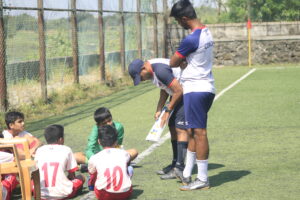PRE PLANNING
When designing soccer training session for players it happens that the coach faces challenge to plan the session according to Age group and Ability of players. Before designing training session it’s important to take key considerations into account to have a successful session for our players.
Points to consider before planning soccer training session for the players.
1. Identify the problem in match situation and choose the objective such as passing, receiving, dribbling, ball control to work on the team for the session . Coach need to visualize that particular objective in match situation for the age group and ability of players you are going to train, this will help you to understand what to expect from your training session.
2. Ask yourself and then note down below questions about the training session
What ? (Session Objective)
Where/Which ? (Part of the field) (Own Half, Opponent Half)
When ? (Moment of the game) (Attacking, Defending, Transition to Attack, Transition to Defend, Set Pieces)
How ? (Ways to achieve objective)
Who ? (players involved, playing position)
Why ? (to plan session) (to improve football action, score goals, defend goals)
3. List down key coaching points and keywords/terms to use during the session
Example :- For Dribbling session.
| KEY COACHING POINTS | KEYWORDS/TERM |
| a) Change of Direction | Zigzag |
| b) Acceleration | Rocket |
| c) Deceiving (Distance & Timing) | Trick/Confuse |
WARM UP
a) Warm up must be dynamic, fun and topic-related. It helps player to activate body muscles for the activity to perform.
b) Consider Holistic approach that includes constraints such as time, space, passive defender, this enhances decision making ability for the players.
c) Instruct only relating to warm up , avoid lengthy stoppages and explanations
d) Observe if the key coaching points are covered unknowingly. Add variations in warm up. It can be movement specific, objective specific
TECHNICAL PROGRESSION
a) More repetitions of the technical activity. Add variations if required
b) Include passive defender, cones, markers as obstruction and identify them as defenders
c) Remember to use only key coaching points and terms on technique specific (Weight of Pass, Touches on Ball), this will help younger players to understand the mechanics of using proper technique on ball.
d) Include competition, add conditions, point system, goal system so players are encouraged and motivated to improve the technique.
f) Demonstrate if required, let the player demonstrate if done properly. Appreciate players on correct execution.
TACTICAL PROGRESSION
a) More repetitions of the tactical situations. Add variations if required.
b) Include active defenders to replicate the technical activity done before at match speed and conditions
c) Include competition, point system, or goal system to challenge them, so they enjoy doing activity at match speed.
e) Ask team members to cheer their teammate, clap hands if the player can perform the task successfully. Even the coach must appreciate and give high five.
f) It is important to challenge players by progressing (+1) or regressing (-1) the activity.
STEPS parameters
S – Size of Grid
T – Time of the activity
E – Equipment’s used for session (markers,cones,bibs,football)
P – Teammate or Opponent
S – Speed/Intensity of Actions
Progression (+1) – Increase difficulty level of the activity for attackers by changing STEPS parameters
Ex:- Using parameter P (by adding opponent)
Ex:- Changing from 4v1 to 4v2
Regression (-1) – Decrease difficulty level of the activity for attackers by changing STEPS parameters
Ex:- Using parameter P (by reducing number of opponent)
Ex:- Changing from 4v2 to 4v1
SMALL SIDED GAMES
a) While your team is defending it is important to coach Player ON the ball, Player AROUND the ball, and Player AWAY from the ball
While your team is attacking it is important to coach Player AWAY from the ball, Player AROUND the ball, Player ON the ball
b) Observe the game, list down & identify the moments where training objective situation will arise.
c) Add conditions in SSG to support the objective
d) Principles of play (Attack & Defend) must complement the match.
e) Coaching on the run & rarely coaching in-game (stoppage)
f) Feedback to be given if the ball goes out of play
g) Use Match Simulation – Simulate the opponents team style of play against your team. Add conditions where your team is losing, winning and how will the players react to this situation.
Following above guidelines will help you to plan better session and understand ways to connect with your players on individual and team level.

IMPORTANT FACTORS TO CONSIDER WHILE PLANNING TRAINING SESSION
| PLAYERS | a) Is the session for the level of the player (i.e. age and ability) ? b) What if the number of players increases or decreases for the activity ? c) Are all players involved in the activity , how are attackers and defenders rotated ? |
| GRID | This indicates distances and dimension of the field used for every activity. a) How are the distances managed for the players? b) What is the dimension of the grid for the activity ? Is it suitable for the age & ability of players ? c) Masking technique i.e. planning smaller grid inside bigger grid |
| TIME | a) How much time for the activity ? |
| EQUIPMENTS | a) How many cones , markers , bibs , and footballs are required for the activity ? b) How are the equipment placed or used for the activity? |
| CONDITIONS and RULES |
Conditions imposed on your player/team to achieve the objective. Conditions imposed on opponent player/team to achieve your objective |



